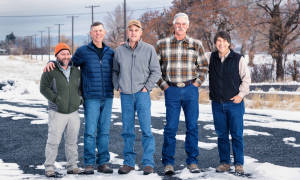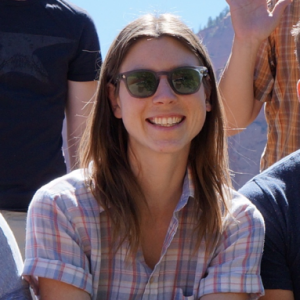By Katherine Daly for EDRBlog.org

The EDR Program interviewed Peter Walker, Professor of Geography at the University of Oregon, about his 2018 book Sagebrush Collaboration: How Harney County Defeated the Takeover of the Malheur Wildlife Refuge. The book argues that the militants who occupied the Malheur National Wildlife Refuge in Harney County, Oregon, in 2016 failed in their objectives because the “citizens of Harney County had invested decades in collaboratively solving the very problems that the militia used to justify their anti–federal government revolution.” More than two years of fieldwork informed the book, which contains a trove of case studies that illustrate what makes collaboration possible and successful.
This interview explores how generations of Harney County residents cultivated fierce independence hand-in-hand with a communitarian ethic. It also discusses how the community’s social capital and unwavering pragmatism laid the foundation for a federal agent and a rancher to overcome decades of strife and collaboratively create the Malheur National Wildlife Refuge Comprehensive Conservation Plan.
Get notified when new articles are posted to the EDR blog – sign up for our email list »
Katherine Daly: Your book focuses on Harney County residents’ collaborative approach to solving problems. What problems were they trying to address?
Peter Walker: A large range of issues, from helping to fight and prevent catastrophic fire to engaging youth in civic activities. Collaboration is an approach that’s been cultivated in the county for decades. I once counted the number of collaboratives in Harney County and it came to about 20.
How did county residents develop this collaborative approach?
One factor is the geography. Harney is the largest county in Oregon—it is the same size as Massachusetts—and has almost the smallest population, with just over 7,000 people. With the physical geography and climate, there’s a real possibility that first responders can’t get to you for hours during an emergency. You have to rely on your neighbors. This has been the case since settlers arrived in the 1860s–70s.
There was and remains a tremendous amount of emphasis on working together. These people are fiercely independent, politically conservative, and don’t want government handouts, but they work together in a way I would call communitarian. For example, the community held a fundraising dinner and created webpages devoted to supporting a local rancher who injured his spine. People have developed a culture of working together because it was necessary.
Geographic isolation is a primary factor in Harney County’s collaborative approach. Are there others?
Contrary to the belief the Malheur occupiers held, Harney County residents didn’t want to overthrow the government. A large majority of people in the county recognize that the federal government can be a valuable partner on issues such as fire, infrastructure, water, and problems such as control of invasive species. In this context, collaboration with the Federal government is a very practical approach. People described it as wanting to “get out ahead” of federal decisions; if those decisions are going to be made, they want to have a seat at the table.
Trust in the federal government is not necessarily a given. Why do Harney County residents believe that federal government agencies will help them?
For one thing,people who work in the agencies are neighbors. Everyone goes to church together and their kids attend the same schools. The fact that there’s a strong sense of working together is not accidental. They work hard to work together.
There are also examples of the federal government following through on promises and creating space for meaningful participation in land management decisions. For one, the Steens Mountain Cooperative Management and Protective Act was written the living room of a prominent rancher in collaboration with federal agencies and other residents. Two years later, a big fire in Harney County wiped out many ranchers’ grazing allotments. In response, the BLM gave them all new allotments.
How is trust maintained when there is a high rate of turnover in Federal agency jobs?
Turnover is a problem in that you lose good people; the agency policy of moving people around a lot is not helpful. What counterbalances that are the collaborative groups—the High Desert Partnership (HDP) and it’s initiatives, the Harney County Restoration Collaborative* and the Harney Basin Wetlands Initiative—all these groups have local people who have been working with the agencies for many years. The agency staff come and go, but the collaboratives have institutional memory. It’s not difficult for the locals participating in these groups to teach people to work together. Generally speaking, new agency staff who join HDP get it pretty quickly. The ones who can’t wrap their minds around the collaborative approach don’t last long in these groups.
It sounds like there are individuals who uphold and expand the practice of collaboration in the County and convene collaborative efforts. Having local leadership and getting the right people to convene is critical. Can you expand on that?
In the late 1990s and early 2000s, there was a lot of tension between the community and the Malheur Wildlife Refuge. This stemmed back to a raft of federal environmental regulations enacted during the 1970s. Laws like the Federal Land Policy and Management Act and the Endangered Species Act had been applied across the Western states, straining relationships between federal agents and those using public land well into the 1980-90s.
At the end of the 1990s, the Refuge appointed a Deputy Project Manager (he became Manager in 2015), who decided to try a new approach. When I asked him what the impetus was, he replied: “failure.” People were so mad at each other they couldn’t accomplish anything. So, he looked at other collaboratives in the Western states, such as the Blackfoot Challenge and the Applegate Partnership, and saw models for how to move beyond the low-level warfare that had characterized government-citizen relationships in Harney County over the past three decades.
The manager saw a partner in one of his permittees, a prominent fifth-generation rancher whose ranch contained lot of public and private land. This rancher realized that it didn’t make sense to manage public grazing allotments and private property differently and had a landscape-scale vision for management. This vision is where the two men saw eye to eye. So, they visited Montana together to learn more about the Blackfoot Challenge and brought the idea back to Harney County.
When did High Desert Partnership materialize and did the organizers have a goal in mind?
HDP hit a major milestone when they gained non-profit status in 2005. But the organizers were thinking about 2013, when the Refuge would be required to have completed a new comprehensive conservation plan. They spent a decade building up HDP so it could develop the new plan collaboratively, rather than have the US Fish and Wildlife Service draft the plan and release it to the public for comments. Instead of using this ineffective process, HDP wanted to have an institution in place that would allow ranchers, conservationists, tribes, and agencies to come up with a plan that would work for everyone.
This plan is still the guiding document for the Refuge. The plan’s publication and the process that created it really succeeded in diffusing the tension. One measure of success is that the Malheur conservation plan has never been sued! Everybody was okay with it because it was their document.
Can you talk more about why folks were willing to participate? What are some key factors that brought people to the table?
Social Capital: A lot of the HDP’s success rides on a high degree of social capital in the community and the experience people have working together. They understand that, whether or not you like your neighbor, you still have to work with them. Moreover, everyone was pretty tired of fighting about the Refuge by the turn of the century. People were ready for something different.
Leadership: Groups and collaboratives need leaders to pioneer new ways of doing business and to be willing to work above and beyond the call of duty. There were a few key individuals with impeccable social standing who are thoughtful, caring, open-minded, and willing to spend a lot of uncompensated personal time to make this work. I’m not sure the Refuge’s plan would have been written collaboratively if these individuals and others like them hadn’t been there.
Meaningful Opportunities to Be Heard: Through the conflicts of the 1970-80s, Harney County’s ranchers were desperate for agencies to hear them. What ranchers wanted the whole time was for federal agencies to structure meaningful opportunities for them to be involved in management discussions from the very beginning. So, there was enthusiasm among the ranching community to have their voices heard. Despite initial doubts and through strenuous efforts, a few local ranchers and the Refuge staff were able to cultivate widespread support for the concept of a partnership.
I asked a Harney County Commissioner about the occupiers’ use of the phrase “federal overreach.” I would summarize his response as this: “To the occupiers, it means that the federal government shouldn’t own land. For a lot of us, it means federal agencies just need to listen to us. We appreciate them being here, but it’s frustrating when they make decisions that aren’t practical, economically or ecologically viable, etc. We understand they have other constituencies they’re responding to, but we at least want to know that they are listening and, if they make a rule that negatively impacts us, they know it. I think that federal overreach is the wrong word. I don’t think it’s overreach, it’s under-listening.”
*Editor’s note: The Harney County Restoration Collaborative is also supported by a branch of the Oregon-based National Policy Consensus Center. The collaborative was designated an Oregon Solutions project shortly after it was convened.

Katherine Daly is the Program Manager of the Environmental Dispute Resolution (EDR) Program at the Wallace Stegner Center, S.J. Quinney College of Law, University of Utah.
